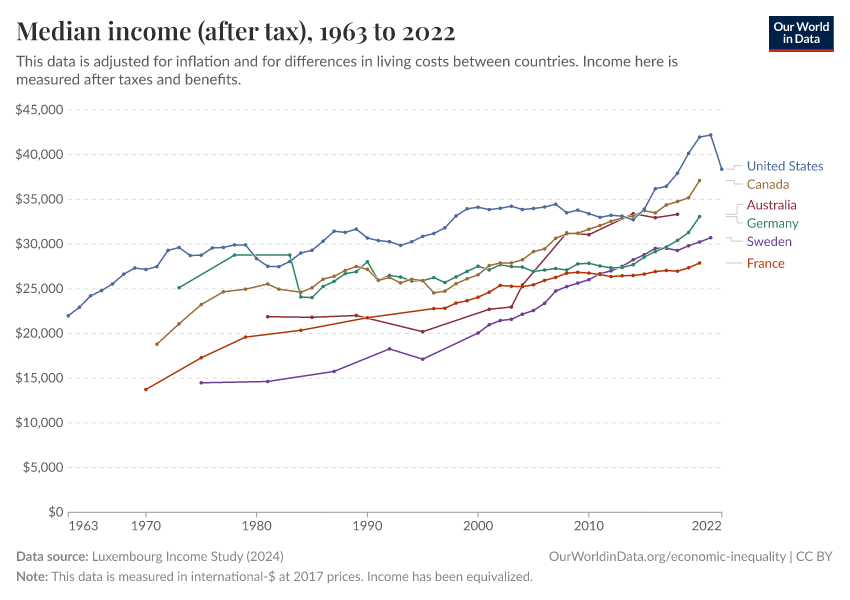Median income (after tax)

What you should know about this indicator
- The data is measured in international-$ at 2017 prices – this adjusts for inflation and for differences in living costs between countries.
- Income is "post-tax" — measured after taxes have been paid and most government benefits have been received.
- Income has been equivalized – adjusted to account for the fact that people in the same household can share costs like rent and heating.
What you should know about this indicator
- The data is measured in international-$ at 2017 prices – this adjusts for inflation and for differences in living costs between countries.
- Income is "post-tax" — measured after taxes have been paid and most government benefits have been received.
- Income has been equivalized – adjusted to account for the fact that people in the same household can share costs like rent and heating.
Sources and processing
This data is based on the following sources
How we process data at Our World in Data
All data and visualizations on Our World in Data rely on data sourced from one or several original data providers. Preparing this original data involves several processing steps. Depending on the data, this can include standardizing country names and world region definitions, converting units, calculating derived indicators such as per capita measures, as well as adding or adapting metadata such as the name or the description given to an indicator.
At the link below you can find a detailed description of the structure of our data pipeline, including links to all the code used to prepare data across Our World in Data.
Notes on our processing step for this indicator
We create the Luxembourg Income Study data from standardized household survey microdata available in their LISSY platform. The estimations follow the methodology available in LIS, Key Figures and DART platform.
We obtain after tax income by using the disposable household income variable (dhi).
We estimate before tax income by calculating the sum of income from labor and capital (variable hifactor), cash transfers and in-kind goods and services from privates (hiprivate) and private pensions (hi33). We do this only for surveys where tax and contributions are fully captured, collected or imputed.
We obtain after tax income (cash) by using the disposable household cash income variable (dhci).
We convert income data from local currency into international-$ by dividing by the LIS PPP factor, available as an additional database in the LISSY platform.
We top and bottom-code incomes by replacing negative values with zeros and setting boundaries for extreme values of log income: at the top Q3 plus 3 times the interquartile range (Q3-Q1), and at the bottom Q1 minus 3 times the interquartile range.
We equivalize incomes by dividing each household observation by the square root of the number of household members (nhhmem). Per capita estimates are calculated by dividing incomes by the number of household members.
We obtain Gini coefficients by using Stata’s ineqdec0 function. We set weights as the product between the number of household members (nhhmem) and the normalized household weight (hwgt). We also calculate mean and median values from this function.
Reuse this work
- All data produced by third-party providers and made available by Our World in Data are subject to the license terms from the original providers. Our work would not be possible without the data providers we rely on, so we ask you to always cite them appropriately (see below). This is crucial to allow data providers to continue doing their work, enhancing, maintaining and updating valuable data.
- All data, visualizations, and code produced by Our World in Data are completely open access under the Creative Commons BY license. You have the permission to use, distribute, and reproduce these in any medium, provided the source and authors are credited.
Citations
How to cite this page
To cite this page overall, including any descriptions, FAQs or explanations of the data authored by Our World in Data, please use the following citation:
“Data Page: Median income (after tax)”, part of the following publication: Joe Hasell, Bertha Rohenkohl, Pablo Arriagada, Esteban Ortiz-Ospina, and Max Roser (2022) - “Poverty”. Data adapted from Luxembourg Income Study. Retrieved from https://archive.ourworldindata.org/20251022-091218/grapher/median-income-after-tax-lis.html [online resource] (archived on October 22, 2025).How to cite this data
In-line citationIf you have limited space (e.g. in data visualizations), you can use this abbreviated in-line citation:
Luxembourg Income Study (2025) – with major processing by Our World in DataFull citation
Luxembourg Income Study (2025) – with major processing by Our World in Data. “Median income (after tax) – Luxembourg Income Study” [dataset]. Luxembourg Income Study, “Luxembourg Income Study (LIS)” [original data]. Retrieved November 4, 2025 from https://archive.ourworldindata.org/20251022-091218/grapher/median-income-after-tax-lis.html (archived on October 22, 2025).